Mabamba swamp or Mabamba Wetlands sanctuary is a vast waterlogged area stretching through a long/narrow papyrus filled channel on the outer showers of Lake Victoria in Entebbe Uganda. Lake Victoria is the largest inland fresh water lake in Africa. Mabamba Bay swamp is located within the wider Wakiso district in a small village known as Kasanje (40 kilometers away from Kampala). The name Mabamba was adopted because the area has abundant lung fish (mamba in the local language).
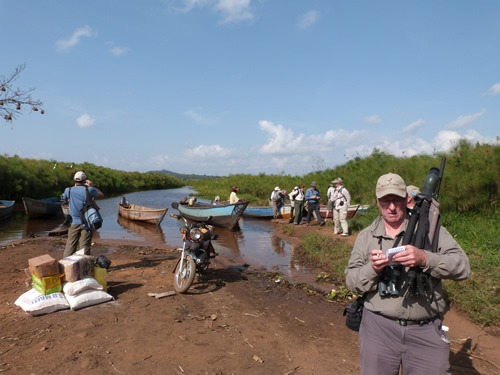 The Mabamba Bay swamp is important to the economic well-being of the local people living in the area. They use the swamp for fishing, hunting of Sitatunga (swamp antelope) and harvesting papyrus for building/craft materials. The water from the swamp is used at home and for domestic animals.
The Mabamba Bay swamp is important to the economic well-being of the local people living in the area. They use the swamp for fishing, hunting of Sitatunga (swamp antelope) and harvesting papyrus for building/craft materials. The water from the swamp is used at home and for domestic animals.
The Mabamba wetlands sanctuary has over 260 species of birds making it an important bird area in Uganda. The wetland is home to 38% of the total population of blue swallows in the world and home to the endangered yellow warbler. Ramsar listed Mabamba as a wetland of international importance in 2006 in order to raise global awareness/concern and the funding necessary to protect it from complete destruction. As population increased in areas close to the swamp, more and more people were looking to the swamp as a source of livelihood. Swamp encroachment became a threat to the biodiversity in the swamp. The numbers of birds and creatures like Sitatunga which thrived in the swamp had been decreasing over the years.
The government of Uganda with support from international partners has curbed encroachment on the wetland and helped promote it as a leading birding destination in the country. The government has 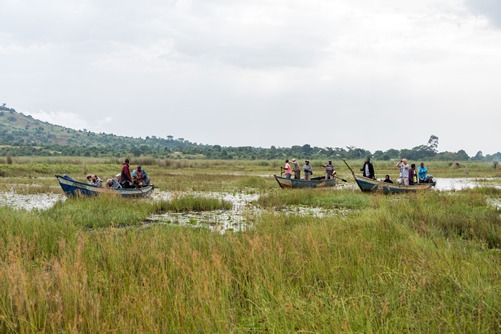 initiated community sensitization programs to deter encroachments and inform them of the importance of the swamp to the Eco-system. They have also been encouraged to take advantage of the opportunities offered by bird tourism in the area. Some of the fishermen are now used as bird Guides since they know every corner of the swamp. As a result of community sensitization, the people living close to the swamp now know the implications of destroying the wetland. They have also been quick to embrace tourism and the opportunities it offers. Tourists on a Uganda safari often make stops in the area to spot birds like the blue swallow, yellow warbler, the papyrus gonolek and the Shoebill stork which we will be discussing in more detail shortly. You might also be interested in the other activities in Entebbe town.
initiated community sensitization programs to deter encroachments and inform them of the importance of the swamp to the Eco-system. They have also been encouraged to take advantage of the opportunities offered by bird tourism in the area. Some of the fishermen are now used as bird Guides since they know every corner of the swamp. As a result of community sensitization, the people living close to the swamp now know the implications of destroying the wetland. They have also been quick to embrace tourism and the opportunities it offers. Tourists on a Uganda safari often make stops in the area to spot birds like the blue swallow, yellow warbler, the papyrus gonolek and the Shoebill stork which we will be discussing in more detail shortly. You might also be interested in the other activities in Entebbe town.
The Shoebill Stork and Birding in Mabamba Swamp Uganda
Of all the bird species living within the Mabamba Swamp, the one that attracts birders to the wetland the most is the Shoebill Stork. The Shoebill Stork is one of the most sought after birds in the world. They are 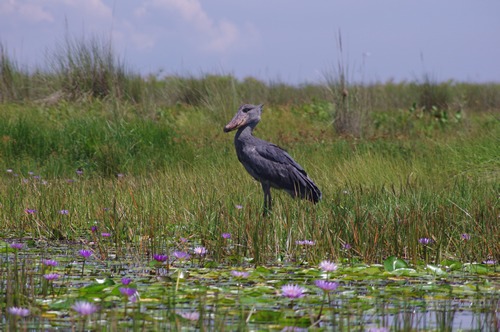 found in Sudan, Uganda, Tanzania, Rwanda and Zambia. Also known as the whale-headed stork, the Shoebill is a large bird with a shoe shaped bill. A male Shoebill stork weighs 5kgs and a female about 4kgs on average. Adults are grey in color while juveniles have orange feathers. The Shoebill has one of the longest bills and can be said to be related to storks and pelicans. Others find it’s odd-looking bill similar to creatures that lived in the Jurassic era. Although large in size, the Shoebill is shy and elusive. It loves to live in the wild and as far away from humans as possible. The Shoebill Stork thrives in waterlogged swamps with less oxygen and where fish need to come up to breathe. The Shoebill feeds fish, frogs, insects and insects. They never migrate away from a specific swamp unless disturbed. In most case, they live alone but they can also be seen in pairs during mating time.
found in Sudan, Uganda, Tanzania, Rwanda and Zambia. Also known as the whale-headed stork, the Shoebill is a large bird with a shoe shaped bill. A male Shoebill stork weighs 5kgs and a female about 4kgs on average. Adults are grey in color while juveniles have orange feathers. The Shoebill has one of the longest bills and can be said to be related to storks and pelicans. Others find it’s odd-looking bill similar to creatures that lived in the Jurassic era. Although large in size, the Shoebill is shy and elusive. It loves to live in the wild and as far away from humans as possible. The Shoebill Stork thrives in waterlogged swamps with less oxygen and where fish need to come up to breathe. The Shoebill feeds fish, frogs, insects and insects. They never migrate away from a specific swamp unless disturbed. In most case, they live alone but they can also be seen in pairs during mating time.
The Shoebill was first discovered by the Egyptians and Arabs but got its scientific name Balaeniceps rex in the 19th century from Europeans. In Uganda, it is locally known as “Bbulwe” and is found in Queen Elizabeth National Park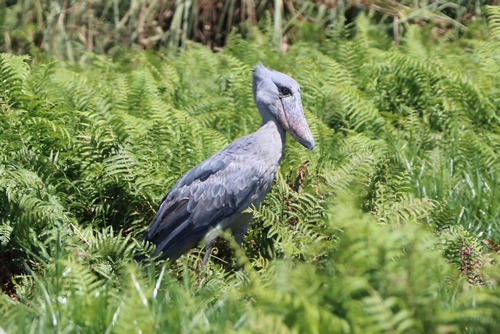 , the Zziwa Rhino Sanctuary, Murchison Falls national park, the West Nile swamps and the Mabamba wetland. The Mabamba wetland is the best and most convenient place to see the Shoebill stork in Uganda. It is also the best place to go birding if you are within Kampala and Entebbe in Uganda. The number of Shoebills in Mabamba swamp had been decreasing due to loss of habitat and killings from the local people who looked at them as a bad omen. Fishermen thought that they brought misfortune if it was the first thing they saw when going out fishing. Tourism has helped improve the image of Shoebills because they are what draws most international birders to the swamp. As we will see later on, fishermen are now less inclined to kill the Shoebills because they earn more as birding guides.
, the Zziwa Rhino Sanctuary, Murchison Falls national park, the West Nile swamps and the Mabamba wetland. The Mabamba wetland is the best and most convenient place to see the Shoebill stork in Uganda. It is also the best place to go birding if you are within Kampala and Entebbe in Uganda. The number of Shoebills in Mabamba swamp had been decreasing due to loss of habitat and killings from the local people who looked at them as a bad omen. Fishermen thought that they brought misfortune if it was the first thing they saw when going out fishing. Tourism has helped improve the image of Shoebills because they are what draws most international birders to the swamp. As we will see later on, fishermen are now less inclined to kill the Shoebills because they earn more as birding guides.
Directions to Mabamba Wetlands Sanctuary in Uganda
There are two routes one can use to get to the Mabamba Swamp by road. One starts from Entebbe and the other from Kampala. From Entebbe town, you will drive up to Kisubi area and then branch to the road leading to Nakawuka. You will then leave Nakawuka and go to Kasanje before proceeding to Mabamba Swamp. If you are arriving from Kampala, you can use the old Entebbe road up to Kisubi and branch to the road leading to Nakawuka. Once you reach Kasanje, you would have reached very close to the swamp.
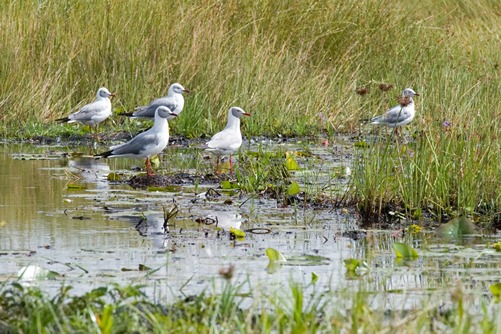 Apart from using a car, you can also use the most convenient but more expensive water transport. Speed boats are available for hire at waterfront beach and the Entebbe sailing club. The journey to Mabamba Bay swamp will take about 40 minutes by boat. A trip by boat is more exciting and scenic allowing you to check out the islands and beautiful beaches in Entebbe. Once you reach the wetland, you have to switch to local canoes owned by the local fishermen in order to navigate through the reeds and papyrus. The fishermen act as birding guides because they know the terrain and where to find the birds. Canoes usually take a maximum of three visitors plus one or two local guides. $35 is paid for the birding experience and the canoe plus $7 to the local village office. The office uses the small fee for the development of social services around the area.
Apart from using a car, you can also use the most convenient but more expensive water transport. Speed boats are available for hire at waterfront beach and the Entebbe sailing club. The journey to Mabamba Bay swamp will take about 40 minutes by boat. A trip by boat is more exciting and scenic allowing you to check out the islands and beautiful beaches in Entebbe. Once you reach the wetland, you have to switch to local canoes owned by the local fishermen in order to navigate through the reeds and papyrus. The fishermen act as birding guides because they know the terrain and where to find the birds. Canoes usually take a maximum of three visitors plus one or two local guides. $35 is paid for the birding experience and the canoe plus $7 to the local village office. The office uses the small fee for the development of social services around the area.
The best time to see the Shoebill Stork is in the morning hours. The fishermen/Guides will be looking for them in areas with a lot of fish and worms. Since they are solitary birds, don’t expect to see a lot of them at once. You will probably only see two or three of them standing on a reed or papyrus and waiting patiently to catch mud fish when they come out to breath. Always have your binoculars in hand to look out for the other species like the blue swallow, papyrus gonolek, yellow warbler, lesser jacana, purple heron, flappet lark, double toothed barbet and more. After observing the shoebills and other species of birds, the fishermen will take you back to your speed boat or to a waiting car. Birding in Mabamba swamp takes between 3 to 4 hours. If you are interested in a full day session, that can also be arranged.
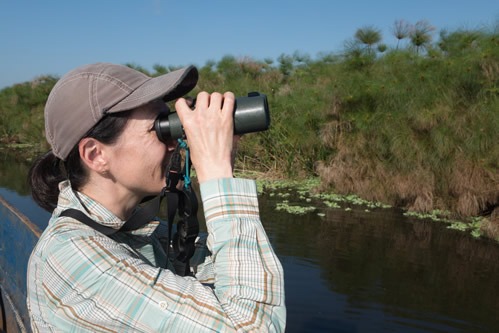 Note: The best time for birding in Mabamba swamp is March and September. This is when most bird species migrate from Europe to Africa to escape the cold winters and look for food. A birding safari experience at Mabamba booked using the services of a local tour operator goes for about $500 a day. For the best experience, it is important to carry travel essential items like a binocular, camera, insect repellents, the right clothes, a raincoat and a life jacket if you can. It is also important for birders to book his/her trip to the Mabamba swamp in advance to allow time for better preparation.
Note: The best time for birding in Mabamba swamp is March and September. This is when most bird species migrate from Europe to Africa to escape the cold winters and look for food. A birding safari experience at Mabamba booked using the services of a local tour operator goes for about $500 a day. For the best experience, it is important to carry travel essential items like a binocular, camera, insect repellents, the right clothes, a raincoat and a life jacket if you can. It is also important for birders to book his/her trip to the Mabamba swamp in advance to allow time for better preparation.
Other attractions in Mabamba swamp Uganda
Watching Butterflies: Mabamba Wetland is home to an amazing collection of butterfly species. As you look out for the birds, you will encounter several species that will make your trip worthwhile. The butterfly species found in Mabamba swamp include abisaraneavei, acrea cansaquine and bicyclus sebetus to mention but a few.
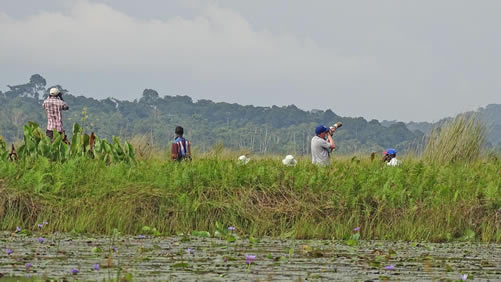 Fishing: The Mabamba Bay swamp may be covered with muddy waters, papyrus and reeds but it also joins the clear water of Lake Victoria. This mixture of clear waters and muddy wetland offers opportunities for fishing. It is also important to note that fishing is the main economic activity in the area. The main species of fish caught is the lung fish, tilapia, Nile perch and mud fish. These are very delicious fish species with two of them (Tilapia and Nile perch) on high demand on the world market.
Fishing: The Mabamba Bay swamp may be covered with muddy waters, papyrus and reeds but it also joins the clear water of Lake Victoria. This mixture of clear waters and muddy wetland offers opportunities for fishing. It is also important to note that fishing is the main economic activity in the area. The main species of fish caught is the lung fish, tilapia, Nile perch and mud fish. These are very delicious fish species with two of them (Tilapia and Nile perch) on high demand on the world market.
Sightings of Sitatunga: The Mabamba wetlands sanctuary is one of the last strongholds for Sitatunga in Uganda. Also known as swamp antelope, the sitatunga is a shy and elusive creature. They are often found alone and rarely with others. If you are lucky, you might spot one moving within the papyrus reeds. Sitatungas are an endangered species because of loss of habitat and hunting/poaching for meat. The Uganda wildlife Authority is trying hard to curb poaching and protect the last remaining habitat of these amazing creatures.
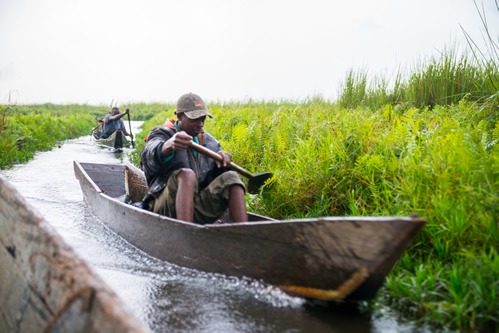 Canoeing: Although canoes are normally used for fishing and birding tours around the wetlands, an adventurous visitor can choose to hire one for the simple purpose of exploring the wetland. The fisherman will take you around the vast swamp and into Lake Victoria.
Canoeing: Although canoes are normally used for fishing and birding tours around the wetlands, an adventurous visitor can choose to hire one for the simple purpose of exploring the wetland. The fisherman will take you around the vast swamp and into Lake Victoria.
Village walks and visiting craft shops: Outside the Mabamba swamp is a settlement/slum with fishing stalls. Taking a tour around the nearby villages is revealing but also humbling. You will have an opportunity to interact with the fishermen, their families and the other local people living in the area. After a tour of the settlements, you can buy souvenir from the artisan shops built just outside the wetland. The products include baskets, mats, huts, sandals, stools and bags made from papyrus/reeds.
General tour of Entebbe town: Entebbe is one of the most naturally beautiful towns in Uganda. It is surrounded on almost all sides by Lake Victoria. The colonial government chose it as the administrative capital of Uganda because of its calm and serene environment. After birdwatching in Mabamba Swamp, a visitor can go to one of the Entebbe beaches to swim and bask in the African sun. The Uganda wildlife education Centre is one place you must visit while in Entebbe. Also known as Entebbe, zoo, the Centre showcases most of the Uganda’s wildlife. You could even visit the Uganda Reptiles village, visit the Entebbe sailing club or the serene botanical gardens at the centre of the town.


